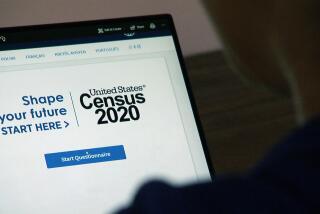Census Bureau Jumps on Media Bandwagon
- Share via
WASHINGTON — Worried that segments of the U.S. population may not fully participate in the 2000 census, federal officials are mounting an ambitious $100-million advertising campaign to sell racial and ethnic minorities on the benefits of being counted.
Young & Rubicam Inc., a giant New York advertising agency, is crafting an overall media campaign--”This is your future. Don’t leave it blank!”--to encourage all Americans to fill out and return the mail-in census forms.
Individual advertising firms, employed as subcontractors to Young & Rubicam, are creating targeted campaigns with overt racial or cultural messages aimed at black, Latino, Asian American and Native American populations. Print and broadcast ads targeted at Native Americans, for instance, draw attention to the family. “Generations are counting on this. Don’t leave it blank!” they say.
For African Americans, media messages evoke racial and community solidarity: “This is our future. Don’t leave it blank.”
And ads aimed at Latinos and Asian Americans translate the catch phrase into Spanish, Japanese, Chinese, Korean and other languages to be used in ads developed for ethnic media.
Bureau Counting on Ads to Lure Residents
A full-scale advertising campaign is a radical--and expensive--departure from the Census Bureau’s historical use of free public-service messages to encourage Americans to participate. But facing a 30-year decline in the number of questionnaires returned and a reluctance of major media to publish public service ads prominently or to broadcast them in prime-time slots, census officials decided to treat the 2000 census as if it were a consumer product. That meant spending big bucks to market the questionnaire directly to an increasingly skeptical public.
“If Burger King and McDonald’s know they have to get out there with a big splash to gain consumers, then we have to do the same,” said David Hoffman, a Census Bureau spokesman.
Hoffman said that during the last census in 1990, the bureau did not mount a paid-advertising campaign, relying instead on pro bono ads that drew an uneven response across the nation. “In Los Angeles, the media responded poorly,” he said. “We didn’t get prime time during ‘Seinfeld’ but ended up during sermonette times around 2 a.m.”
Hopes That Campaign Will Reverse Trend
This time, the bureau concluded that it has to mount a full-scale Madison Avenue assault with slick ads and messages to reach all Americans, something akin to paid-advertising campaigns by the Army and Postal Service.
If successful, the Young & Rubicam campaign will help reverse a three-decade trend of diminishing public response to census questionnaires. Since 1970, when the response rate was 78%, the percentage of those completing and mailing the forms declined to 75% in 1980 and 65% in 1990. Officials project a 55% response rate in 2000 if the trend continues.
Census officials said their concerns about a possible undercount of minority Americans are exacerbated by the recent Supreme Court decision prohibiting the use of statistical sampling to augment traditional methods of mail responses and door-to-door enumeration.
Although the court’s decision applies only to congressional apportionment, it remains unclear whether sampling methods will be used at all. In addition to adjusting congressional seats in some districts, the distribution of an estimated $180 billion in federal aid to the states could be affected by the 2000 census.
A major reason for the declining response rate stems from the nation’s increasing diversity, according to demographers and statisticians familiar with census surveys. Racial minorities and recent immigrants tend to be reluctant to assist federal officials, often expressing fear that the information may be used against them. Studies also suggest that some immigrants do not understand why the U.S. government would count them. The net effect is that, as the U.S. population swells with minority groups, many of them are undercounted.
“It is a major challenge for the 2000 census to be as accurate as possible and to count every American living in the country,” said Kenneth Prewitt, director of the Census Bureau.
Prewitt estimated that the bureau spends about $2 per questionnaire for every returned form but it’s $12 each when census takers are required to call or visit individual households. For the hardest-to-reach Americans, the bureau forecasts spending as much as $36 per questionnaire.
At a recent meeting here of a 2000 census advisory group, Census Bureau officials and Young & Rubicam executives unveiled the early outlines of the advertising campaign, which they hope will increase awareness of the census mail-in questionnaire and persuade Americans to respond.
Special-market advertising firms will create advertising messages and purchase media time or space in ethnic and minority outlets. Chisholm-Mingo, a black-owned New York firm, has the African American account. Gray & Gray of Albuquerque will produce the ad strategy for Native Americans. Young & Rubicam subsidiaries Mosaica and Bravo Group will handle Asian American and Latino advertising, respectively.
The campaign will include direct mail and special events designed to “create a sense of importance, excitement, urgency and relevance” for those participating in the census. The actual advertising campaign, which will include ads on national television networks, in major newspapers and on big-city radio stations, is not expected to get underway until the spring of 2000.
Congress has yet to approve the Census Bureau’s $100-million budget request for the advertising campaign, and current funding for census activities expires on June 15.
More to Read
Inside the business of entertainment
The Wide Shot brings you news, analysis and insights on everything from streaming wars to production — and what it all means for the future.
You may occasionally receive promotional content from the Los Angeles Times.










